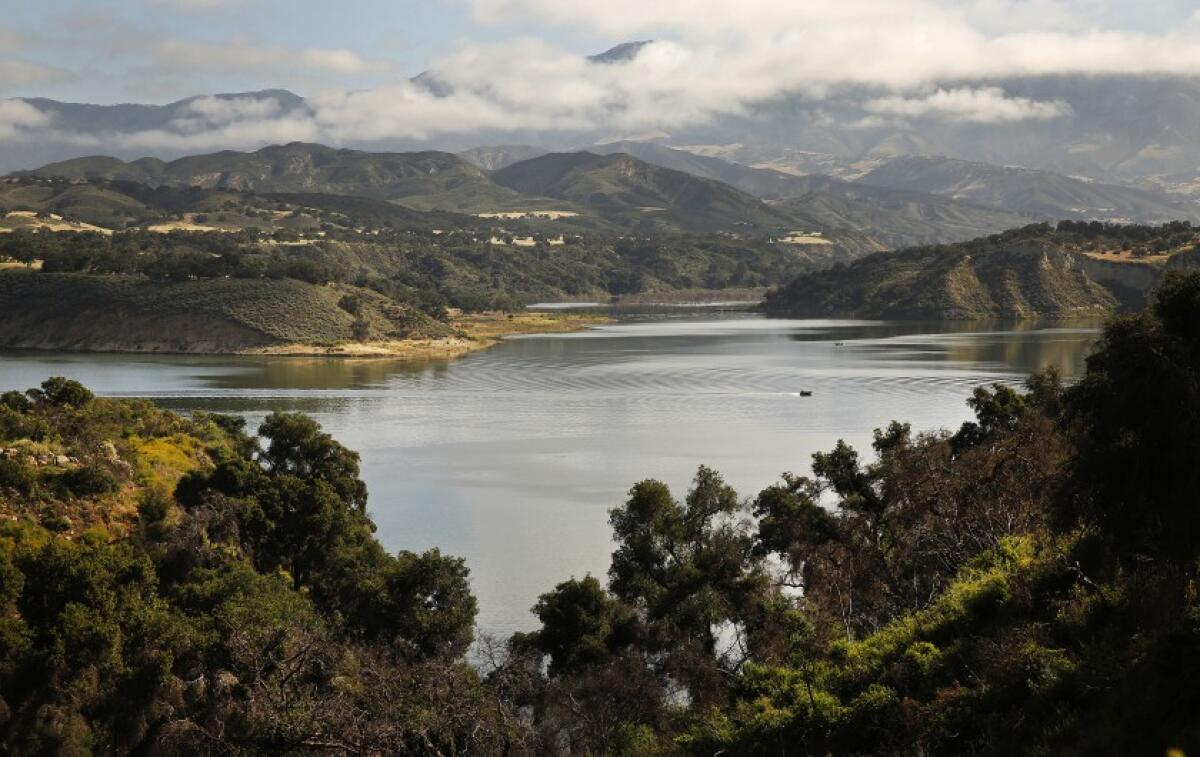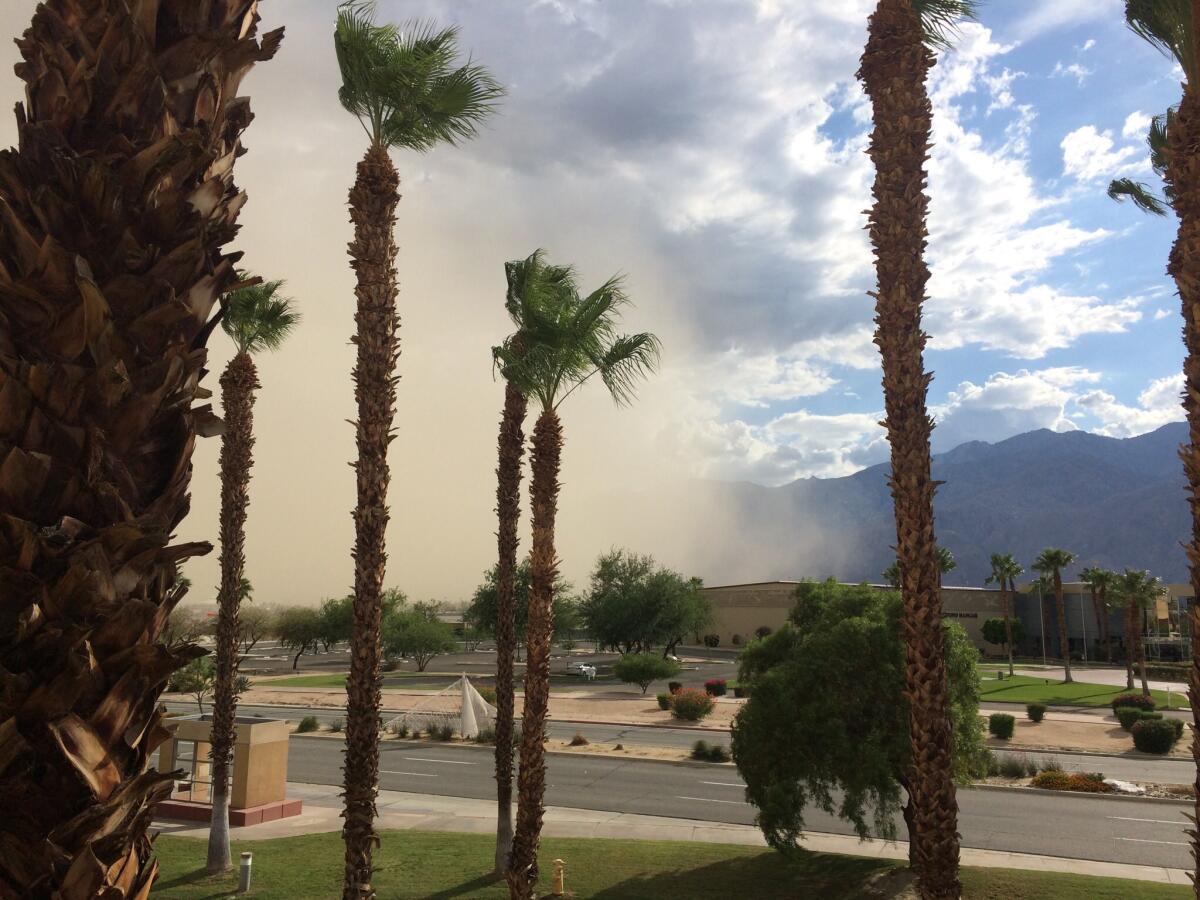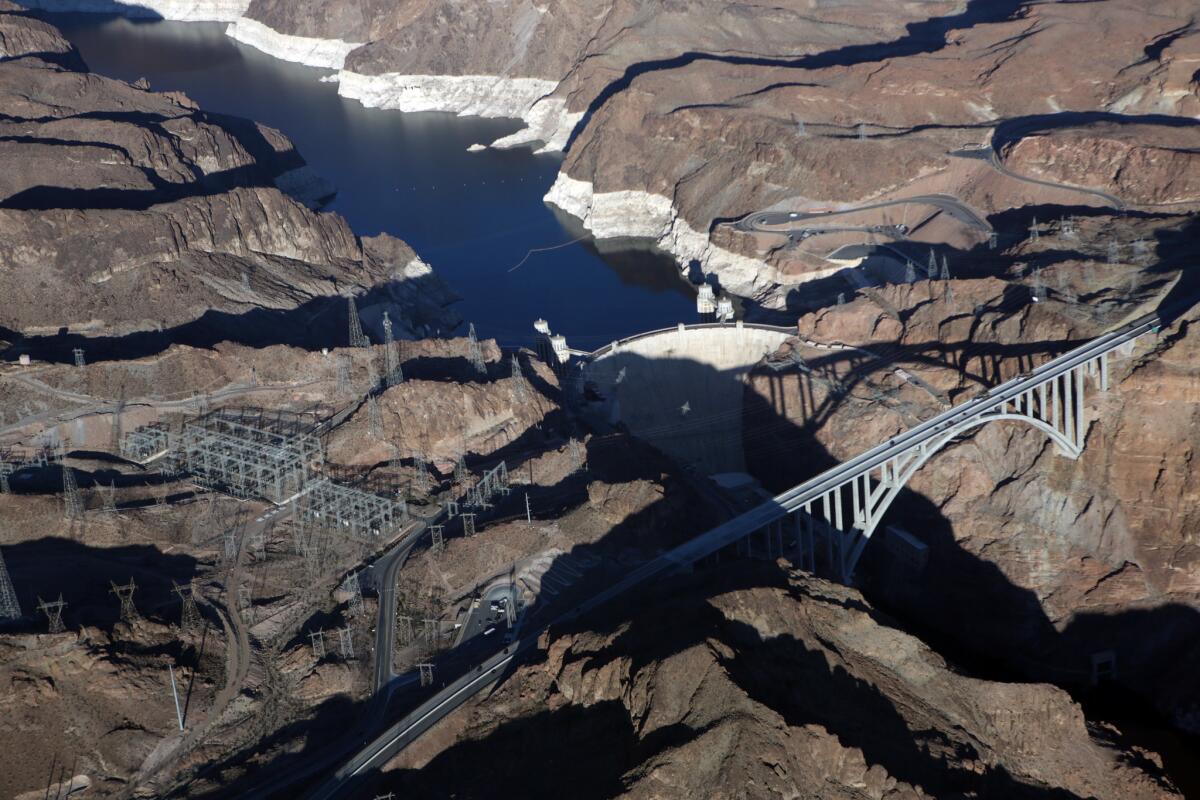Why is Warren Buffett, the ‘Oracle of Omaha,’ betting on a future with fossil fuels?
- Share via
There’s a running joke among political insiders that in Washington “every week is Infrastructure Week.” It’s a winking reference to how the Trump administration will periodically declare it’s shifting its focus to investing in America’s crumbling infrastructure, only to be sidetracked by the president’s off-topic remarks or other distractions.
Well, this week is definitely Infrastructure Week, but not in a way the Trump administration ever would have wanted.
On Sunday, two of the country’s biggest power companies, Dominion Energy and Duke Energy, canceled plans to build the $8-billion Atlantic Coast pipeline, which would have carried natural gas 600 miles through West Virginia, Virginia and North Carolina.
Then on Monday, a federal judge ordered Energy Transfer Partners to shut down and remove all oil from its Dakota Access pipeline, handing a victory to the Standing Rock Sioux Tribe and the Cheyenne River Sioux Tribe. Later in the day, the Supreme Court refused to let construction start on another controversial project, TC Energy’s Keystone XL oil-sands pipeline.
Climate change activists celebrated the decisions as proof that protests and lawsuits against fossil fuel infrastructure are working, as Marianne Lavelle reported for InsideClimate News.
But there was one more piece of news that jumped out at me. Dominion, which is headquartered in Virginia, also announced it would sell its natural gas pipelines, gas storage fields and other assets for $9.7 billion.
Toward a more sustainable California
Get Boiling Point, our newsletter exploring climate change, energy and the environment, and become part of the conversation — and the solution.
You may occasionally receive promotional content from the Los Angeles Times.
The buyer? Berkshire Hathaway Energy, one of many arms of Warren Buffett’s investing empire.
The deal includes 7,700 miles of pipelines and a 25% stake in the Cove Point liquefied natural gas export facility in Maryland. Once the sale is finalized, Berkshire will own 18% of all interstate gas transmission in the United States, according to CNBC.
I immediately wondered: Why is Buffett — the so-called Oracle of Omaha, a billionaire investor famous for his foresight — betting nearly $10 billion on natural gas at a time when leaders in California and other states are talking about phasing out the planet-warming fossil fuel? Where does Buffett see long-term value for gas in a climate-constrained world?
I’ll cut to the chase and tell you — I don’t know. A Berkshire spokeswoman told me via email that the company would “respectfully decline” my interview request. I offered to send written questions, to which she replied: “We are also declining the opportunity to respond to written questions.”

Buffett didn’t do much to explain his thinking in a news release, saying the company is “proud to be adding such a great portfolio of natural gas assets to our already strong energy business.” Berkshire’s energy chief, Bill Fehrman, offered only slightly more detail, saying the purchase “expands our company’s footprint in several Eastern and Western states as well as globally.”
In the absence of clear answers, I thought about all the stuff I’ve learned about Berkshire over the years.
The firm’s MidAmerican Energy subsidiary, which is based in Iowa and sells electricity to customers in four Midwestern states, is known for its wind power investments. But MidAmerican got 46% of its electricity from coal, the dirtiest fossil fuel, in 2018.
The story is similar for PacifiCorp, a Berkshire subsidiary with electricity customers in six Western states, including California. PacifiCorp is adding large amounts of wind and solar power, but 61% of its electricity mix still came from coal in 2018.
In Nevada, Berkshire’s NV Energy subsidiary plans to buy electricity from the country’s largest solar farm outside Las Vegas. But contrast that with Buffett’s 2010 purchase of BNSF Railway, which moves large amounts of coal and, along with other railroad operators, funded climate science denial for decades, as the Atlantic’s Robinson Meyer revealed in an excellent story last year.
Buffett has also resisted calls from some investors to explain how his company’s insurance division is responding to climate risks.
So what’s the lesson here? Berkshire, like most companies, mostly cares about making money. Buffett will invest in clean energy when he sees an economic opportunity. But he has no qualms profiting from climate-disrupting fuels, either.
Clark Williams-Derry, an analyst at the Institute for Energy Economics and Financial Analysis, told me Berkshire is known for buying “stable, reliable businesses when they’re cheap.” But while gas infrastructure may have looked like a safe bet a few years ago, he said, plummeting solar and wind power prices have changed the equation. So has the growing momentum for climate action — as evidenced by the eight states now targeting 100% clean energy, and by the successful activism against oil and gas pipelines.
“The electricity sector is changing so rapidly that it’s no longer a stable business that provides you that 10- to 15-year view that you need to make a reliable investment” in gas, Williams-Derry said.
Buffett has a history of missteps in energy investing. Earlier this year, for instance, crashing oil prices forced the Oracle of Omaha to acknowledge that his $10-billion investment in Occidental Petroleum was a mistake.
“He may be making a riskier bet here than he realizes,” Williams-Derry said, referring to the Dominion purchase.
Americans still burn plenty of natural gas for heating, cooking and electricity. The fuel isn’t going away tomorrow, or next year.
But clean energy advocates see an increasingly grim outlook for all fossil fuels — including gas, which supporters still describe as a “bridge fuel” from coal to renewables despite mounting scientific evidence of the dangers it poses to the planet’s climate.
David Pomerantz, executive director of the Energy and Policy Institute, a climate watchdog group, said there are growing signs that pipelines and other gas infrastructure could become “stranded assets.” He noted that even before canceling the Atlantic Coast pipeline, Dominion scaled up its solar and wind ambitions and shelved plans to build thousands of megawatts of gas-fired power plants, following Virginia’s adoption of a 100% clean energy law. Other utilities have made similar retreats from gas.
“There’s a real chance that that gas bridge or gas bubble, whatever you want to call it, will dissolve much sooner than anybody expects,” Pomerantz said.
Berkshire has a lot to lose if fossil fuels continue to decline, and not just from its pipeline business. A new report this week from M.J. Bradley & Associates, tracking pollution from the 100 largest U.S. electricity producers, found that Berkshire emitted the fifth-most carbon dioxide of any power company in 2018, with 44% of its electricity coming from coal and 26% from gas.
By carbon emissions rate, a metric that takes into account a company’s size, Berkshire was closer to the middle of the pack. Nearly one-quarter of the firm’s electricity came from renewables in 2018, not a small amount.
I asked Dan Bakal — senior director of electric power for the sustainability nonprofit Ceres, one of several groups and companies that commissioned the report — for his reaction to Berkshire buying Dominion’s gas infrastructure. He described the sale as an “important step for Dominion,” which is targeting net-zero carbon emissions by 2050.
But why would Buffett drop nearly $10 billion on fossil fuel assets in 2020? Like me, Bakal was puzzled.
“That’s exactly the question that we’ll be asking them, and many of their investors will as well,” he said.
Here’s what else is happening around the West:
TOP STORIES

Climate change is creating water supply challenges in California. Overall, the state hasn’t been getting less rainfall in recent decades. But Bettina Boxall reports for The Times that global warming is already resulting in bigger swings between dry times and wet times, a trend that will force Californians to change the way they use and manage water. Bettina also examines data showing that the water-saving habits we were all urged to adopt during the 2012-16 drought seem to have stuck.
Fireworks are terrible for our lungs. If you were one of the people setting off fireworks for the Fourth of July ... please don’t do that again. I stepped outside on Sunday into a neighborhood that seemed to be shrouded in fog, and quickly learned the previous night’s fireworks had caused hazardous air quality, to the point where L.A. had the worst air quality of any major global city. Not good, since pollution makes our lungs more susceptible to COVID-19. More details here from my colleague Alex Wigglesworth.
Sunrun was already the largest U.S. rooftop solar installer. And now the San Francisco-based company is acquiring its top rival, Vivint Solar of Utah, in a $3.2-billion deal announced this week, as Emma Foehringer Merchant and Karl-Erik Stromsta report for Greentech Media. In addition to solar, Sunrun is a leader in battery storage, with more than 10,000 systems installed so far.
CLIMATE IMPACTS
Climate change could eliminate Joshua trees across most of Joshua Tree National Park. But in Yucca Valley, a town along the park’s northern edge, residents worry that designating Joshua trees as an endangered species — which state officials are considering — would be economically devastating, as Louis Sahagun reports for The Times. The area’s state assemblyman, Chad Mayes, has introduced a bill that would limit protections for plants and animals being considered for endangered species status.
New research finds that dust storms — which are becoming more common in the Southwest as the planet warms — are associated with more hospitalizations for respiratory distress. Here’s the story from Bloomberg’s Breanna T. Bradham. Not a healthy trend for our lungs, especially with COVID-19 spreading.

Climate change often operates in the background, through forces like sea level rise that exacerbate challenges large and small. Take, for instance, the huge waves that overwhelmed coastal defenses in Newport Beach this weekend, flooding parts of the California city, as chronicled by my colleague Rosanna Xia. Or consider the more intense flooding San Diego expects to experience as the Pacific Ocean continues its advance, as discussed in this story by the San Diego Union-Tribune’s David Garrick.
Enjoying this newsletter? Consider subscribing to The Times
Your support helps us deliver the news that matters most, and makes newsletters like Boiling Point possible. Become a Los Angeles Times subscriber.
POWER STRUGGLES
America detonated 67 nuclear bombs in the Marshall Islands. Now federal officials claim that a leaky dome storing radioactive waste is safe — but also that a nearby lagoon is “so contaminated with radioactive elements that any additional spillage from the dome would be undetectable.” Reassuring! Here’s the story by The Times’ Susanne Rust, whose coverage of U.S. nuclear testing in the Marshall Islands prompted congressional scrutiny (and was recently honored by the Society of Professional Journalists).
California oil regulators keep approving new fracking permits. To the chagrin of clean energy advocates, Gov. Gavin Newsom’s administration has authorized another dozen hydraulic fracturing permits, this time for Chevron, as the Bakersfield Californian’s John Cox reports. This follows two dozen permits in April and a dozen more in May. Interestingly, the company that received those earlier permits says it’s not fracking most of the wells yet because low oil prices have “made it not economic to continue.”
A new report examines how utility companies use charitable giving to build support for fossil fuel investments and rate hikes. Tom Perkins wrote a detailed piece for HuffPost on the report, which details the huge sums of money that utilities such as Duke, Dominion and Pacific Gas & Electric have given to charity, and the ways those charities often go to bat for their sponsors.
WATER IN THE WEST
Eating meat is not great for the Colorado River. I was stunned by a new study finding that 55% of the water consumed in the Colorado River Basin is used to grow crops to feed cattle — although maybe I shouldn’t have been, because, as someone pointed out to me on Twitter, there was a similar statistic in an excellent book I read a few years back. Anyway, more details on the study here, from the Guardian’s Troy Farah. As someone who eats beef, I can’t help but think about my own culpability.

An audit found that major U.S. companies, including Coca-Cola, FedEx and Walmart, have been using huge amounts of water in Baja California without paying for it. Some companies, allegedly, have illegally dumped wastewater, contributing to cross-border pollution that flows into the U.S. through the Tijuana River, as Wendy Fry reports for the San Diego Union-Tribune.
“In a land of finite resources, every choice, big or small — irrigating an alfalfa field, taking a swing on a golf course, burning fossil fuels — means choosing what kinds of habitat exist, even far away from town.” That was one of many sentences I loved in this beautiful story by Maya L. Kapoor for High Country News about the endangered Yaqui catfish, the only catfish native to the American West, and the scientists who are wading through streams trying to learn more before it’s too late.
What do you want to know?
When you think about California’s climate future, what comes to mind? What keeps you up at night, and what gives you hope or gets you excited? What do you want to understand, and what should I?
This newsletter is for you, to help you understand how we’re changing our world and what we can do about it, and I want to hear your questions, concerns and ideas. Email me or find me on Twitter.
ONE MORE THING
Let’s end with a “Hamilton” tie-in (sort of), in honor of the musical’s release on Disney+ this past weekend.
I just started a book called “The Source: How Rivers Made America and America Remade Its Rivers,” by the water scientist Martin Doyle. Reading the first chapter, I was fascinated to learn that the Constitutional Convention came about in part because George Washington — before he became president — wanted to move goods along the Potomac River, and because the federal government struggled under the Articles of Confederation to facilitate interstate commerce. I tweeted the relevant passage:
“As Teddy Roosevelt would argue over a century later, the Constitution had its roots in interstate river navigation,” Doyle wrote.
Pretty nifty.
I’ll be back in your inbox next week. If you enjoyed this newsletter, please consider forwarding it to your friends and colleagues.




